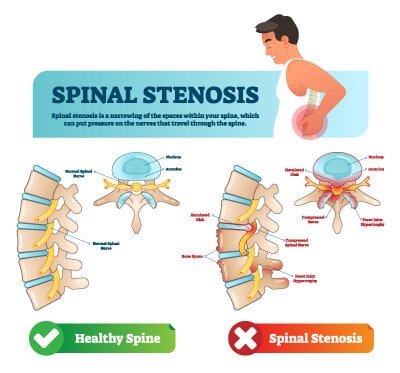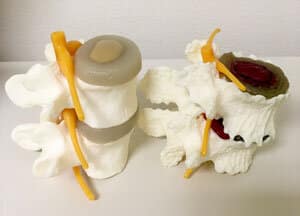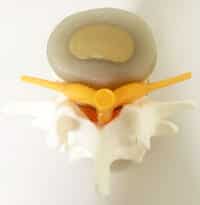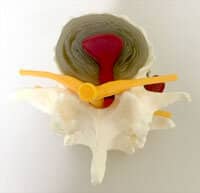What is Spinal Stenosis?
Spinal stenosis is a problem that about 50% of Americans will have by the time they reach the age of 70. Spinal stenosis is the narrowing down of the opening where the spinal cord travels.
Common Symptoms of Spinal Stenosis
Common symptoms that patients will often feel are pain, numbness, tingling, burning, and/or weakness in the legs. They often feel pain in the back, but sometimes they won't feel pain at all.

What Causes Spinal Stenosis?

Normal Discs vs. Degenerated Discs
In order to explain what causes spinal stenosis, let’s take a look at a 3-D model for a textbook normal spine that shows the lowest two vertebrae in the back (See Picture: Normal Discs vs. Degenerated Discs. Normal Disc is shown on the left, and Degenerated Disc is on the right). The two vertebrae show a normal disc. We have two discs here that are normal height, normal thickness, there's no thinning of them. Additionally, we don't see any bone spurring here and we see the nerves coming out that are connected to the spinal cord. Those nerves affect the feeling and the function in the legs.
Now, let’s look at a model demonstrating degeneration in the two lowest vertebrae in the back. As we start having the effects of aging and wear and tear on the spine, we’ll start to see some disc thinning, we’ll see that the disc dry out. I often describe a degenerated disc like a piece of beef jerky that is dried out, it's very brittle and it doesn't move or bend very well.
A healthy disc is much different. It's well hydrated, it's thick, it has a healthy springiness to it, and it functions more as a shock absorber between the vertebrae. When we look at a degenerated spine versus a healthy one, we’ll often see that the disc is thinned down. We’ll see that the opening where the nerve comes out has narrowed, which can cause nerve impingement. Even more importantly, if the disc thins down and starts bulging towards the back of the canal, this causes a closing down on the canal and it narrows the opening! As a result, when this occurs, Spinal Stenosis is present.

Normal Spine - Top Down View
This shows a normal looking spine on the end, so we're looking at it from a top down view. We can see the spinal cord here and the nerves that come off the spine. Those nerves actually go out and form the sciatic nerve and the plexus of nerves that go down the legs. The two functions for those nerves are for sensation and motor activity. If these nerves get pinched, they can affect the muscles and the feeling in the skin.
Notice what happens to the spine from age, wear and tear, and a closing down of the spinal canal. Now, we have a bottleneck in the opening, and the disc compressing back towards the cord.

Degenerated Spine - Top Down View
How Do the Causes of Spinal Stenosis Impact the Symptoms You Experience?

Let's take one step further by thinking about the symptoms. The nerves travel down the legs from the low back. Therefore, if the cord gets pinched, it's going to affect the associated nerves. Look at the picture with the stripes on the human body. With this diagram, we can see what we call dermatomes (dermatomes are patches of skin where these nerves travel). If you pinch the respective nerve, it could potentially affect the feeling that the skin has over the corresponding surface area. Every nerve that comes off the spinal column, and there are 31 pairs of them, has a Patch of skin that it affects.
One can conclude that if the nerve is working properly, a patient will feel normal sensation and they'll be able to detect the sense of touch and other common sensations that we feel when something touches our skin. However, if the nerve gets compressed, it’s going to cause pain, numbness, tingling, or burning to travel to those specific dermatomes.
"Conventional" Treatment Approach to Spinal Stenosis
Ordinarily when patients develop Spinal Stenosis, one of the common treatments or the “conventional treatment approach” is to do a back surgery called a Laminectomy. In a Laminectomy, they actually take the back part of the vertebrae and they remove it. Although it does decompress the spine, it causes a lot of stability issues and many times these surgeries fail because the back loses stability with the more bone and tissue they remove. In many cases of somebody with spinal stenosis, once the back part of the vertebrae is gone, we’ll often see the vertebrae start to migrate forward. Unfortunately, when that happens the patient starts having those same symptoms again like pain, numbness, tingling, burning, and weakness down the leg. Ironically, the surgery can actually lead to further problems in the future.
What kind of Non-Surgical Treatment for Spinal Stenosis Do We Offer?
At Health 1st Wellness & Physical Medicine, we use a non-surgical, non-invasive treatment called Spinal Decompression Therapy to treat Spinal Stenosis.
Spinal Decompression reverses the compression of the spine non-surgically, and it won't jeopardize the stability of the spine. It reverses the narrowing of the opening where the spinal canal travels, thus widening the opening. Spinal decompression reduces the pressure on the spinal cord.
Dr. Roth Explains Spinal Stenosis
If a patient doesn't have permanent nerve damage, he or she is going to experience potential increase in strength in his or her legs. If one had pain, numbness, tingling or burning going down his or her legs, it's going to usually go away. Spinal decompression therapy can help to get the patient’s normal functions to return without having to do any kind of surgical procedure or risk any complications that might occur in surgery.
Want To Find Out If You Are A Candidate For Treatment?
If you have Spinal Stenosis and would like to find out if you are a candidate for this non-surgical treatment, call our office at 501-881-4407 to schedule an appointment! We offer a Free Consultation to new patients. During the consultation, you will be able to discuss your condition with the doctor and ask any questions you may have.

